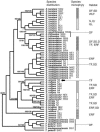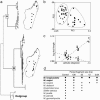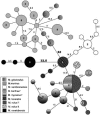A multidimensional approach for detecting species patterns in Malagasy vertebrates
- PMID: 15851666
- PMCID: PMC1131875
- DOI: 10.1073/pnas.0502092102
A multidimensional approach for detecting species patterns in Malagasy vertebrates
Abstract
The biodiversity of Madagascar is extraordinarily distinctive, diverse, and endangered. It is therefore urgent that steps be taken to document, describe, interpret, and protect this exceptional biota. As a collaborative group of field and laboratory biologists, we employ a suite of methodological and analytical tools to investigate the vertebrate portion of Madagascar's fauna. Given that species are the fundamental unit of evolution, where micro- and macroevolutionary forces converge to generate biological diversity, a thorough understanding of species distribution and abundance is critical for understanding the evolutionary, ecological, and biogeographic forces that have shaped Malagasy vertebrate diversity. We illustrate the means by which we apply Mayr's "three basic tasks" of the systematist [Mayr, E. (1942) Systematics and the Origin of Species from the Viewpoint of a Zoologist (Harvard Univ. Press, Cambridge, MA)] to identify, classify, and study the organisms that together constitute Madagascar's vertebrate community. Using field inventory methods, specimen-based studies, and morphological and molecular analyses, we formulate hypotheses of species identity that then serve as the foundation for subsequent studies of biology and history. Our experience, as well as that of other investigators, has shown that much of the vertebrate species diversity in Madagascar is "cryptic" for both biological and practical reasons. Beyond issues of cryptic biological diversity, the resolution of species identity in Madagascar has been hampered because of a lack of vouchered comparative material at the population level. Through our activities, we are attempting to remedy these limitations while simultaneously enhancing research capacity in Madagascar.
Figures






References
-
- Mayr, E. (1995) Philos. Sci. 63, 262-277.
-
- Mayr, E. (1942) Systematics and the Origin of Species from the Viewpoint of a Zoologist (Harvard Univ. Press, Cambridge, MA).
-
- Goodman, S. M. & Benstead, J. P., eds. (2003) The Natural History of Madagascar (Univ. of Chicago Press, Chicago).
-
- Coffin, M. F. & Rabinowitz, P. D. (1992) in Geology and Geophysics of Continental Margins, eds. Watkins, J. S., Zhiqiang, F. & McMillen, K. J. (American Association of Petroleum Geologists Memoir), Vol. 53, pp. 207-246.
-
- Storey, M., Mahoney, J. J., Saunders, A. D., Duncan, R. A., Kelley, S. P. & Coffin, M. F. (1995) Science 267, 852-855. - PubMed
Publication types
MeSH terms
Substances
Associated data
- Actions
- Actions
- Actions
- Actions
- Actions
- Actions
- Actions
- Actions
- Actions
- Actions
- Actions
- Actions
- Actions
- Actions
- Actions
- Actions
- Actions
- Actions
- Actions
- Actions
- Actions
- Actions
- Actions
- Actions
- Actions
- Actions
- Actions
- Actions
- Actions
- Actions
- Actions
- Actions
- Actions
- Actions
- Actions
- Actions
- Actions
- Actions
- Actions
- Actions
- Actions
- Actions
- Actions
- Actions
- Actions
- Actions
- Actions
- Actions
- Actions
- Actions
- Actions
- Actions
- Actions
- Actions
- Actions
- Actions
- Actions
- Actions
- Actions
- Actions
- Actions
- Actions
- Actions
- Actions
- Actions
- Actions
- Actions
- Actions
- Actions
- Actions
- Actions
- Actions
- Actions
- Actions
- Actions
- Actions
- Actions
- Actions
- Actions
- Actions
- Actions
- Actions
- Actions
- Actions
- Actions
- Actions
- Actions
- Actions
- Actions
- Actions
- Actions
- Actions
- Actions
- Actions
- Actions
- Actions
- Actions
- Actions
- Actions
- Actions
- Actions
- Actions
- Actions
- Actions
- Actions
- Actions
- Actions
- Actions
- Actions
- Actions
- Actions
- Actions
- Actions
- Actions
- Actions
- Actions
- Actions
- Actions
- Actions
- Actions
- Actions
- Actions
- Actions
- Actions
- Actions
- Actions
- Actions
- Actions
- Actions
- Actions
- Actions
- Actions
- Actions
- Actions
- Actions
- Actions
- Actions
- Actions
- Actions
- Actions
- Actions
- Actions
- Actions
- Actions
- Actions
- Actions
- Actions
- Actions
- Actions
- Actions
- Actions
- Actions
- Actions
- Actions
- Actions
- Actions
- Actions
- Actions
- Actions
- Actions
- Actions
- Actions
- Actions
- Actions
- Actions
- Actions
- Actions
- Actions
- Actions
- Actions
- Actions
- Actions
- Actions
- Actions
- Actions
- Actions
- Actions
- Actions
- Actions
- Actions
- Actions
- Actions
- Actions
- Actions
- Actions
- Actions
- Actions
- Actions
- Actions
- Actions
- Actions
- Actions
- Actions
- Actions
- Actions
- Actions
- Actions
- Actions
- Actions
- Actions
- Actions
- Actions
- Actions
- Actions
- Actions
- Actions
- Actions
- Actions
- Actions
- Actions
- Actions
- Actions
- Actions
- Actions
- Actions
- Actions
- Actions
- Actions
- Actions
- Actions
- Actions
- Actions
- Actions
- Actions
- Actions
- Actions
- Actions
- Actions
- Actions
- Actions
- Actions
- Actions
- Actions
- Actions
- Actions
- Actions
- Actions
- Actions
- Actions
- Actions
- Actions
- Actions
- Actions
- Actions
- Actions
- Actions
- Actions
- Actions
- Actions
- Actions
- Actions
- Actions
- Actions
- Actions
- Actions
- Actions
- Actions
- Actions
- Actions
- Actions
- Actions
- Actions
- Actions
- Actions
- Actions
- Actions
- Actions
- Actions
- Actions
- Actions
- Actions
- Actions
- Actions
- Actions
- Actions
- Actions
- Actions
- Actions
- Actions
- Actions
- Actions
- Actions
- Actions
- Actions
- Actions
- Actions
- Actions
- Actions
- Actions
- Actions
- Actions
- Actions
- Actions
- Actions
- Actions
- Actions
- Actions
- Actions
- Actions
- Actions
- Actions
- Actions
- Actions
- Actions
- Actions
- Actions
- Actions
- Actions
- Actions
- Actions
- Actions
- Actions
- Actions
- Actions
- Actions
- Actions
- Actions
- Actions
- Actions
- Actions
- Actions
- Actions
- Actions
- Actions
- Actions
- Actions
- Actions
LinkOut - more resources
Full Text Sources
Research Materials

